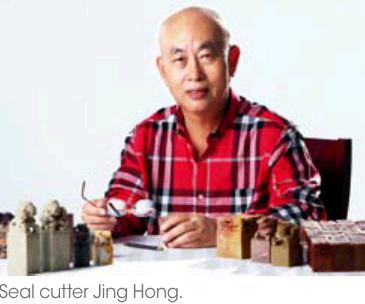Rock of Ages
At ypical seal contains only a handful of characters. However, 33-by-18-meter Yundong Rock in Zhangzhou, Fujian Province, was engraved with all 5,000 words of Lao Tzus Tao Te Ching. The man who completed the worlds biggest seal cutting work was Jing Hong, a renowned seal cutter across China and even Southeast Asia.
Road to Master
Jing Hong was born in 1946 to a calligrapher father. His interest in calligraphy and seals became apparent at an early age due to his fathers influence.
However, notable poet and epigraphy expert Guo Moruos mentorship ultimately steered Jing towards life-long devotion to the seal-cutting arts. Jings family happened to live next door to Guos second wife Sato Tomiko. One day, at the age of eight, Jing visited Sato, and Guo happened to also be visiting his ex-wife. Guo was impressed by seals the eight-year-old had made, so he referred Jing to renowned Sichuanese calligrapher Lan Jusun, who became Jings first mentor. As the years rolled by, Jing also received instruction from other literary and art masters such as Zong Baihua and Zang Kejia.
Jing showed extraordinary talent in the art even at an early age. After a seal he crafted especially for Guo won lofty acclaim, the elder recommended he engrave seals for famous writers Mao Dun, Ba Jin, and Zang Kejia, as well as other celebrities such as Dramatist Ouyang Shan and Painter Guan Shanyue. Over five decades, Jing has crafted more than 20,000 seals,ultimately becoming a seal cutting master.
It is hard for a seal cutter to stand out amidst so much seal cutting talent in China, never mind developing a recognizably singular style. Jing learned from Lan Jusun, but continually explored artistic paths that had never before seen traffic.
Over decades, he studied numerous seal monographs such as those in the Shanghai Museum and conducted in-depth research of private and official seals of the Warring States Period (476-221 B.C.) and horse-branding seals during the Wei, Jin, Southern, and Northern dynasties (220-589), as well as bird-worm seal scripts, pictorial seals, and signatures of various dynasties. He also explored the two southern and northern distinctive painting styles represented by Wu Changshuo and Qi Baishi. Through absorbing highlights of a wide array of arts, he created his own unmistakable style.
Jing injected his understanding of oracle bone inscriptions, bronze inscriptions, and totems of ancient times into his seal cutting work, which sated it with profound traditional cultural meaning. He named his style “totem school.” Before engraving a name seal, he will refer to Analytical Dictionary of Characters (an ancient Chinese dictionary) and relevant genealogy so as to obtain insight into the origin and meaning of each character in the name. For this reason, his seals are often imbued with sublime cultural aesthetics.

Engraving Literary Classics
Jings long-time devotion to seal cutting kindled passion in pinpointing the origin of names and characters. More than a decade ago, he quit his job as a newspaper editor and began to rove around China by van. During his trip, he engraved seals for 12,000 people whose names contained rarely-seen characters. He later compiled artistically embellished inscriptions of those seals into the two-volume Seal Collection for Ten Thousand People.
For a long time, Jing dreamed of advancing and spreading traditional Chinese culture through seal cutting art. Based on such an idea, he began to cut the full text of Tao Te Ching.
In 1994, he engraved the first line of the Taoist classic. Over the following two years, he etched the books 5,000 characters onto 1,109 seals. In 1998, he spent eight and a half months copying the seals onto Yundong Rock in Zhangzhou, Lao Tzus hometown, and painted them red. The magnificent engraving covers about 500 square meters, with the smallest seal measuring 0.4 square meters and the largest 2.4 square meters – and involving almost every style of Chinese seal cutting.
Later, he cut 64 diagrams from the Book of Changes and the full text of the Trimetric Classic (an ancient Confucian primer) into seals. In recent years, his most notable work is oracle bone inscriptions he carved on rocks of Lotus Mountain in Guangzhou. The earliest discovered Chi- nese writing script, oracle bone inscriptions are ancient Chinese characters carved on tortoise shells and animal bones. To date, archeologists have discovered more than 7,000 oracle bone characters, of which some 5,000 have been interpreted. Within four months since June 2008, Jing and his students carved 5,000 characters on rocks in Lotus Mountain. “Mr. Guo Moruo dreamed of compiling a dictionary of oracle bone inscriptions while he was alive,” Jing sighed, “but his dream never came true.” Jing decided to continue working for the dream after Guos passing. He is preparing to publish a book of the 5,000 oracle bone inscriptions he gathered, which has already been edited.
Jing still longs to share seal cutting with the entire world. “Like many other seal cutters, I was delighted when ‘Chinese Seal, Dancing Beijing became the emblem of the 2008 Olympics,” he recalls, “because it offered a perfect opportunity for traditional Chinese art to spread around the world. Perhaps engraving Chinese literary classics is the best way, which spreads both traditional Chinese culture and seal cutting to the world.”
China Pictorial2014年1期
